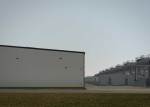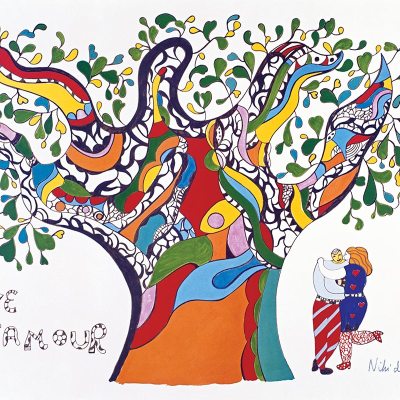While I was watching Farm (Pryor Creek, Oklahoma) (2015), one of two recent works by John Gerrard currently on show at Thomas Dane Gallery, the other person I was sharing the gallery with wandered over to the screen and put their nose right up against the projected image. This was an urge I also had; getting up close might shed some light on what I was watching. In the work, a camera inches 360 degrees around what appears to be an industrial plant, all silver diagonals and rounded cooling towers. The building sits heavy in a vast flat landscape, and if it were not for the camera’s gentle pan I’d have guessed that the work was made up of artfully staged photographs, each one subtly different from the last. In fact it is neither a video nor a photograph: Gerrard’s film is a simulation made of real-time computer graphics. As a study in hyperreality, it’s utterly unnerving.
It took a year to make Farm using advanced technology employed by the military and, more widely, the gaming industry. A crisp digital recreation of a very real place, the industrial building at the heart of Gerrard’s work is a Google data farm which stores a colossal amount of virtual information. Here lie all our old emails, fruitless web searches and pointless social media messages. Farm, in fact, emerges from Gerrard’s urge to expose the internet and debunk the idea that it is some otherworldly force – to make physical its ephemerality. But revealing the infrastructures underlying cyberspace wasn’t easy: when Gerrard contacted Google about the possibility of photographing this large data complex in Oklahoma, he was told an emphatic no. Instead he hired a helicopter and produced an impressive photographic survey of the site: an act of intrusion that mimics Google’s own watchful surveillance techniques.
John Gerrard surveys Google Inc. Data Centre at Pryor Creek, Oklahoma from helicopter. Photo: Blake Gowriluk

The work’s heightened realism is made doubly eerie by Gerrard’s scientific gaze; the cool circling of the plant is both grimly expectant and alienating. This detached interest in utilitarian industrial structures (Farm emerged from Gerrard’s Grow Finish Unit series, which focused on a pork production plant in the US Midwest) calls to mind the works of Bernd and Hilla Becher, as well as the highly constructed topographical photographs of Candida Höfer and Thomas Struth. But equally crucial to Gerrard’s work is the isolated rural landscape in which the Google farm sits – the endless horizon line symbolic of the expansive reach of modern technology. The stark division seemingly drawn between the digital landscape and the natural one suggests a world at odds with itself. Maybe it’s the steady roll of the camera, or the way twilight creeps in, but there is something bleak in this vision of technological evolution.
Installation image from Solar Reserve at Lincon Centre, New York, presented in association with the Public Art Fund. Photo: James Ewing

Gerrard has spoken about how he sees his simulations as portraits – albeit virtual ones – and there is much that is painterly about his works. The other dazzling piece in this exhibition, Solar Reserve (Tonopah Nevada) (2014), evolves into something resembling a 19th-century pointillist painting. This work simulates a solar power plant in the Nevada desert: 10,000 mirrors are arranged concentrically around an illuminated turbine, moving in real-time according to the sun’s position. As the perspective moves hourly from ground level to an aerial view, the whole scene becomes abstracted, the mirrors transformed into uniform blue-hued dots. Perhaps because of its eventual satellite vantage point, Solar Reserve – much more than Farm – feels like a handmade simulation, its digital seams a little looser. But like Farm, it depicts a structure of power embedded within, and in fact dominating, an isolated landscape. Gerrard is keen to bring into view, to show from all angles, the hidden systems fuelling our modern world.
Solar Reserve was recently shown on a huge screen in New York’s Lincoln Plaza. It’s jarring – deliberately so – that a work inviting us to slow down was installed in one of the world’s most fast-paced urban centres – even more so given that its focus is the isolated desert. It’s an intervention that itself seems to echo Gerrard’s wider fiddling with reality. I would imagine there were a lot of people wandering up to the screen to get a much closer look.
‘John Gerrard: Farm’ is at Thomas Dane Gallery, London until 21 March.
Related Articles
Review: Bernd and Hilla Becher at Sprüth Magers (Will Martin)
Reflecting the network: James Bridle’s recent residency and the rise of drones (Kasia Maciejowska)
Post-Surveillance: Suzanne Treister’s riposte to ‘Post-Internet’ art (Digby Warde-Aldam)
Mirrorcity: Glimpsing the digital revolution (Jessica Furseth)
New Horizons: British art and flight (Maggie Gray)




